In Part 1, I wrote about Patrick Byrne’s early years and education. This post is to gather references to the first part of his professional career.
Patrick Byrne was discharged from the harp school in Belfast on Tuesday 14th May, 1822, with his certificate of accomplishment and good conduct, and with a new harp that was given to him by the Irish Harp Society. From that point on he was no longer being supported by the Society; he had to make a living. I think the whole point of his education at the Harp School was to train him up to be a professional harper playing the traditional wire-strung Irish harp, like a vocational training or apprenticeship scheme. And this was one reason why the school focussed on blind pupils; they had very few other opportunities to make a living at that time. But Byrne had been well trained, learning intensively in turn from the respected tradition-bearers Arthur O’Neil, Edward McBride, and Valentine Rennie. Patrick Byrne would have been aged in his mid 20s at that point.
Patrons and testimonials, 1822-6
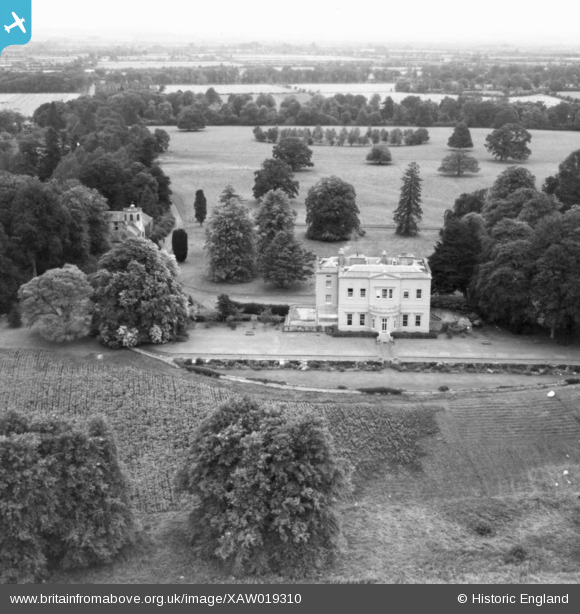
The first reference I have found after Patrick Byrne’s discharge is from a bit over a year later. There is a letter of recommendation kept in Patrick Byrne’s papers at the Public Record Office of Northern Ireland (PRONI D3531/G/1). It is in extremely poor condition and I was not able to read all of it. It is headed “…[erville]” (as if that were the place), and is signed [S …… us] Somerville, and dated “[??] September 1823”, and says “the bearer P Byrne is an excellent Harper & an honest quiet and good man…” and asks “all persons” to help him. From this we can instantly see that the Somervilles were acting as patrons for Byrne by this date. I think this must be Sir Marcus Somerville, 4th Baronet (c.1772-1831). Somerville House is East of Navan, in County Meath. We will meet the Somerville family again later.
After this, there is a gap of five-and-a-half years where I don’t yet have any direct references to what Byrne was doing between September 1823 and April 1829. The Gentlemen of the Irish Harp Society kept track of him; his name is included in a list presented to the Society’s meeting on 24th August 1826, of “Pupils gaining their bread throughout the Kingdom; Harp being given to them by the Society” (Irish Harp Society Calcutta 1828, Penn Libraries ML1015.C3I7, p.44). But this does not tell us what work he was doing, or where. My assumption at this stage is that Byrne was working privately for aristocratic patrons in Ireland, including Somerville.
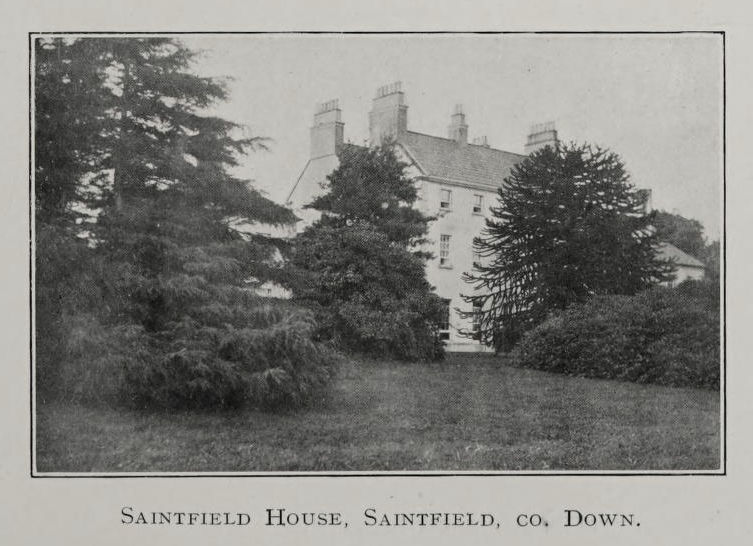
Byrne seems also to have been working at Saintfield House at this time. There is a later testimonial letter in PRONI D3531/G/1 written by Nicholas Price (1754-1847), of Saintfield, and dated Fri 5 Dec 1845, which says “This is to certify that Patrick Byrne has, for the last twenty years been frequently attending this house, by my desire as Harper…” which suggests Byrne was going to Saintfield in the mid 1820s already. The letter is also countersigned by Price’s daughter, Elizabeth Ann Blackwood (1782-1867).
Going to England
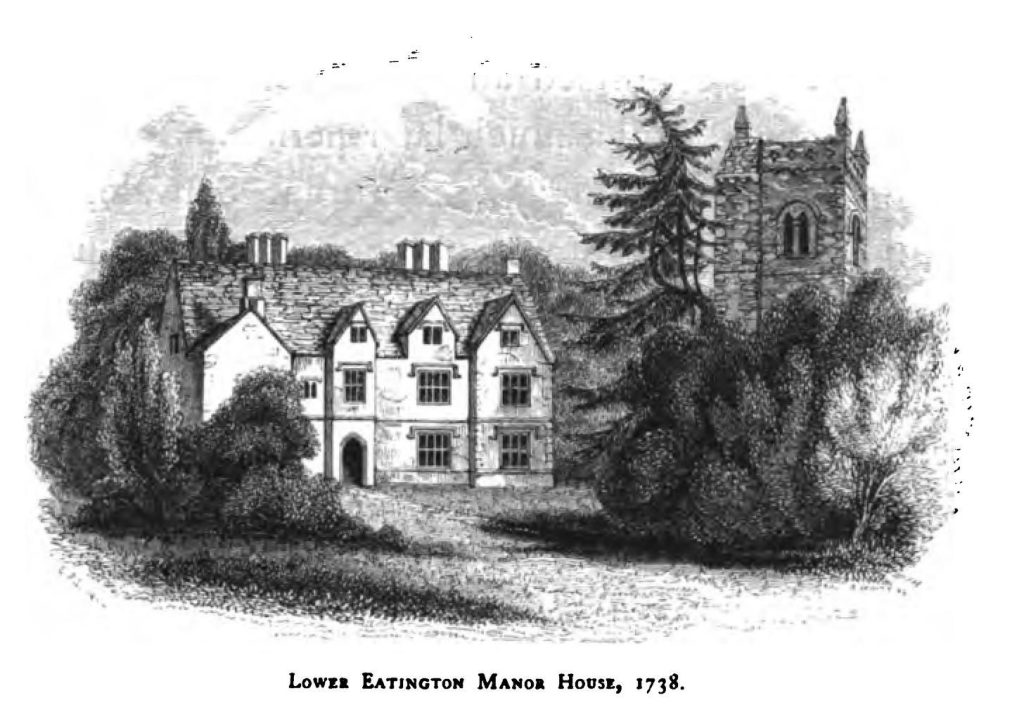
But Patrick Byrne’s most important patron was surely Shirley. Evelyn John Shirley (1788–1856) was an English aristocrat who lived at Ettington Park in Warwickshire, England. Shirley also owned a large Irish estate in Farney, county Monaghan, and so the Byrne family were his tenants; but as his parliamentary biography describes, the family’s Irish estate was run by an agent, and so initially the family does not seem to have had anything to do with the place. In 1824 Evelyn J Shirley was made Sherriff of Monaghan, and so he decided to set up a second household there. In 1826 he started building Lough Fea House just south-west of Carrickmacross, and from then on spent some time each year at Lough Fea, though his main home continued to be Ettington Park in Warwickshire.
We have a reference in January 1838 that Byrne “for the last twelve years has been chiefly resident in England” (The Scotsman, Wed 24 Jan 1838), and so it looks like Shirley may have started employing Patrick Byrne as his harper in 1826, perhaps at the same time as he started building Lough Fea house. Shirley continued to live mostly at Ettington Park, and so I think that from then on Byrne would have mostly been over in England, working in Warwickshire, under the patronage of Evelyn J Shirley and his wife Eliza.
The Shakespeare dinner, 23 Apr 1829
Patrick Byrne’s first public event that I have seen so far, was in the town hall in Stratford-upon-Avon.
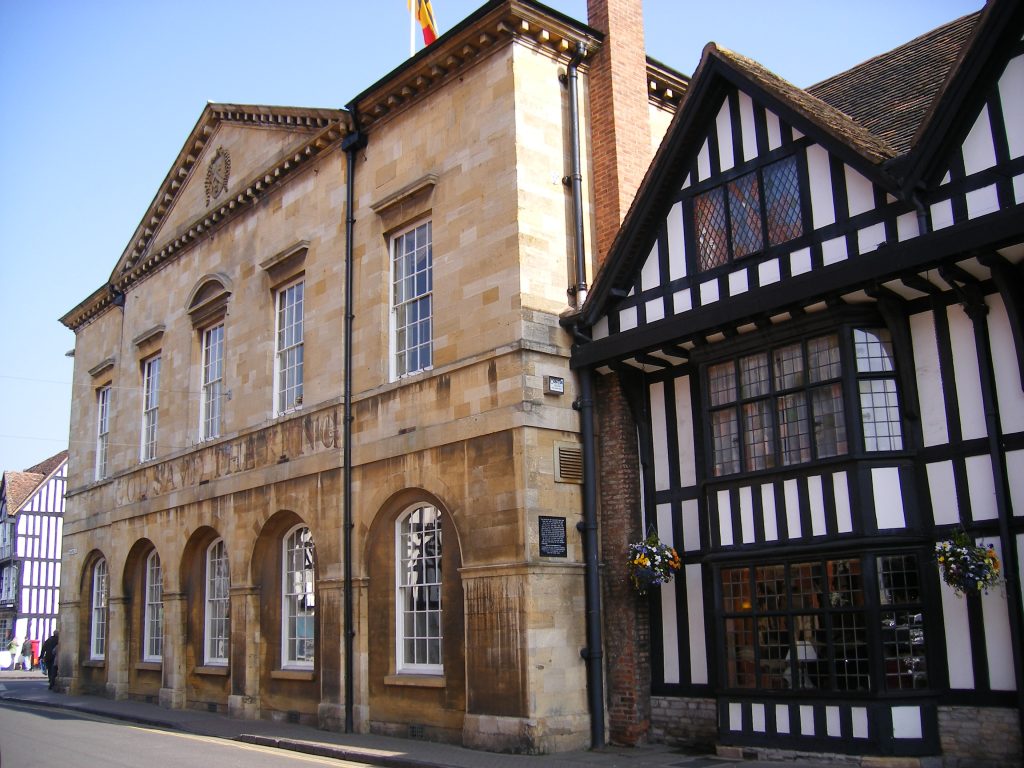
Sir, you are welcome to our feast,
Leamington Spa Courier, Sat 11 April 1829 p2, reprinted Sat 18 Apr p2, also in the Warwick and Warwickshire Advertiser, Sat 18 Apr 1829 p3.
It must appear in other ways than words,
Therefore I scant this breathing courtesy.
_____________
THE
FIFTH ANNIVERSARY DINNER
OF THE
SHAKSPEREAN CLUB,
WILL BE HELD
At the town hall,
ON THURSDAY, APRIL 23rd, 1829;
IN COMMEMORATION OF
THE BIRTH-DAY
OF THE
“Bard of Avon.”
THE Chair will be taken at Three o’Clock precisely, by the Worshipful THE MAYOR, (WILLIAM CHATTAWAY, Esq.) The Professional Singers from Birmingham, who gave such very great satisfaction at the last club dinner, to upwards of 200 Gentlemen, are again engaged, as is also the celebrated Harper, Mr. Byrne, who is so remarkable for producing
“Sounds, and sweet airs, that give delight and hurt not.”
SHAKESPEARE.
N.B. An early application for Tickets to Mr. JOHN ASHFIELD, is requested.
Falcon Inn, Stratford-on-Avon, April 10, 1829.
I checked the previous years but I am not seeing earlier reference to Byrne at these events before 1829. There was a long write up of the day’s events in the Leamington Spa Courier Sat 25 Apr 1829 p.2-3. Details include that “the bells of the Parish Church continued ringing, and cannon were fired, at intervals, during the remainder of the day”. At this time the church had six bells; they were recycled into the current ten in 1948. The main event was a dinner which started at 3pm; there were over 200 gentlemen present. There was a band present; and the professional singers are named as Mr. Bratt, Mr. Riley and Mr. Ke[n]worthy. The report details every speech and toast, and describes the various songs and airs after each one, saying who performed what.
After a few toasts, and their appropriate songs,
Here Mr. Byrne, the Blind Harper, brought from Ireland by E. J. Shirley, Esq. , and patronised by him and his friends, was introduced; and played with great feeling, the favourite air of “Auld lang syne” and “The Bold Dragoon;” both of which elicited considerable marks of approbation.
Leamington Spa Courier Sat 25 Apr 1829 p.2
“The Ladies” – “The Members for the County.”
WALTZ – By Mr. Byrne, the Harper.
GLEE – Fill the bowl with rosy wine. – By Messrs. Bratt, Riley, and Kenworthy.
“Our late worthy townsman, Dr. Connolly.” – (b???? applause,) – AIR (on the Harp). – Auld lang syne.
We can think about Byrne’s choice of repertory (he seems to play Auld Lang Syne as a harp instrumental tune twice) and we can also cringe with him at the Gentlemanly English context. But at least he was getting work, and hopefully being well paid!
Byrne played again after a very long speech:
AIR (on the Harp) – There is nae luck about the House. Played with very great feeling by Mr. Byrne.
Leamington Spa Courier Sat 25 Apr 1829 p.3
A toast was proposed to Evelyn John Shirley Esq., but he did not get a tune or a song.
The Shakespeare Club is still running. In some of the earlier news articles from the 1820s there is mention of the club members wearing specially produced medals; the Shakespeare Blog discusses medals in general but I am not finding specific details year by year during the 1820s. The reason to be interested in the medals is that Patrick Byrne had one; it is mentioned in his will:
To Dr Fleming my kind friend in Bailieborough I will and bequeath a silver medal of William Shakespeare which was given to me by the Shakespeare Club of Stratford Upon Avon in 1829.
Will of Patrick Byrne, 2nd November 1846 (Warwickshire County Record Office, CR229/box18/5, transcription online by Keith Sanger, 2011)
In his second will of May 1859 the medal is described “with the head of Shakespeare” (PRONI D3531/G/6).
The Heberden Coin Room at the Ashmolean Museum in Oxford has examples of 2 different medals issued by the Shakespearean Club. There is one by Westwood and Ottley with just text on the reverse, and another by Ingram with two figures crowning Shakespeare with laurels on the reverse (the illustration shown here is another example of this design). Both commemorate the founding of the club in 1824. I don’t think we can tell at this stage which of these two designs Byrne’s medal was. The museum also has examples of two of other Shakespeare commemorative medals which were issued in 1827, but which don’t mention the Club (here and here); they may have been issued independently or by a rival organisation.
Dinner in the Crown Hotel, 12 May 1829
A housewarming dinner with champagne, toasts, songs and speeches was organised for Mr Rogers when he became the new landlord of The Crown Hotel in Leamington Spa.
…During the evening a number of excellent songs were sung, which contributed greatly to the hilarity of the meeting; which was in no small degree heightened by the admirable performance of Mr. Byrne on the Harp. The company separated at a late hour, highly pleased with their entertainment.
Leamington Spa Courier, Sat 16 May 1829 p2
A regular job: Copps’ Royal Hotel
By August 1829 we see Patrick Byrne in what was to become a regular job for him, playing in Copps’ Royal Hotel in Leamington Spa. The notice makes it sound as if he was already an established fixture in the Royal. I don’t know when he might have started this job; the new hotel was opened in June 1827. Unfortunately the building is no more; it was demolished in 1847 when the railway was built. There is an information plaque under the railway bridge on the site.
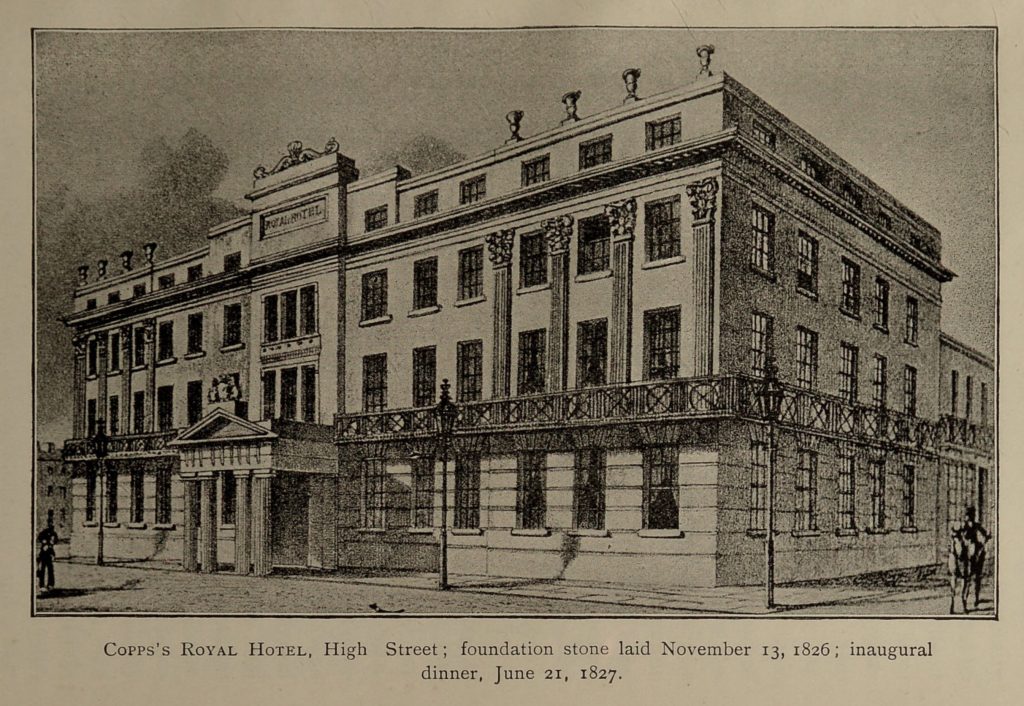
The numerous company who daily assemble at the Public Table at the Royal Hotel, still continue to be cheered by the enlivening strains of Mr. Patrick Byrne, the Irish Harper, who, though like his predecessor, O’Neill, deprived of sight, his countenance and soul seem wrapt up in the melodious tones he elicits from his delightful instrument. In his Battle of the Nile we almost feel the glowing pride and pomp of war and victory; and the old Irish airs which he plays with such admirable execution, must bring to the recollection of many of his hearers the glowing deeds of their forefathers, who led on their bold and gallant bands to victory.
Leamington Spa Courier, Sat 29 Aug 1829 p2
Back in Ireland, summer 1830
Our records are still patchy, and we cannot make a week-by week or even month-by-month itinerary for Patrick Byrne at this early stage of his career. We just have fragments that give us hints as to what was going on. I am sure in the future we might be able to fill in some these gaps from other sources, such as private papers of his patrons, but for now I will carry on with what I have. We are very lucky that Patrick Byrne’s own private papers were preserved by the Shirleys and are now available to consult in Belfast at the Public Record Office of Northern Ireland.
I think there are three documents in Patrick Byrne’s private papers which are dated August and September 1830.
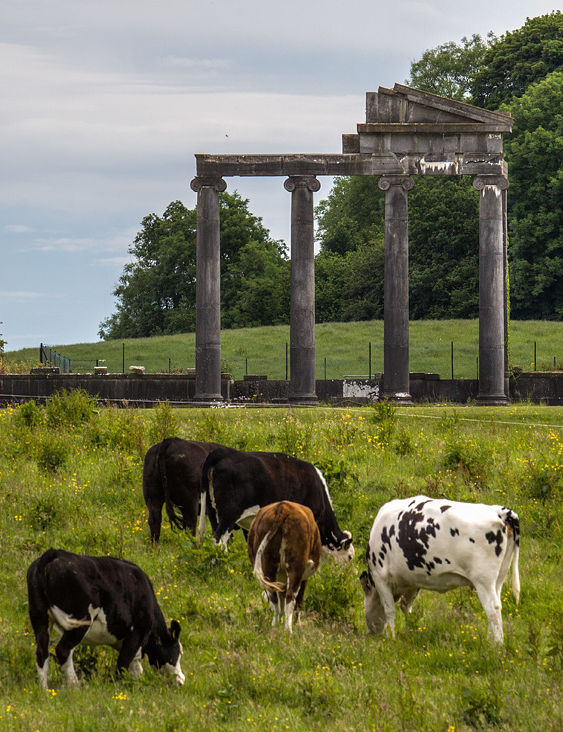
The first is a letter of recommendation (in PRONI D3531/G/1) written by Selina Napier, at Loughcrew, near Oldcastle in County Meath, to her sister, Harriett Wise, at Woodcote near Warwick. I think the date of the letter is 2 Aug 1830 (but I might be misreading it, it might be 2 Aug 1850). The letter has a black border, suggesting that some relative of Selina Napier has died. She says she wants to recommend Byrne; she says “you may have heard him…” and she emphasises that he plays softly and is “a very quiet respectable person to have in the house”. The handwriting is very hard to read. Anyway, it looks like Byrne may have been at Loughcrew in the early summer of 1830. But it also looks like he is wanting to expand his networks in England by asking for this recommendation. And I assume he asked for this, to hand-deliver it, since it is not in the Wise papers at Woodcote, but in Byrne’s private papers that he himself kept.
Next (in PRONI D3531/G/3) is a letter addressed to Mr. P Byrne, Irish Harper, at Sir Manus Somerville’s, Flemingtown, Navan, and dated Tue 3 Aug 1830. Presumably by then Byrne had moved on to Somerville House, or at least it was the next place on his itinerary and so he could expect to receive letters there. The letter contains a praise poem to Patrick Byrne, written by the poet James Martin; it begins “hail matchless minstrel sweetest child of song / whose skilled hand awakens these magic strains …” and continues in this vein for 60 lines.
A month later, Byrne is back at Loughcrew. We have a very curious text in PRONI D3531/G/3 written by Byrne himself (or rather, dictated by him to someone else to write out, since he was blind). The letter is dated Wed 1 Sep 1830. It is in the form of a long poem, headed “Lines addressed to Miss ______ of ______ in answer to her elegant, friendly and poetical letter of May 1829”. There is no envelope, and it may never have been intended to be sent, so I don’t know how to work out who it is addressed to. The letter that she had written to him in May 1829 is not preserved in Byrne’s papers. This poem he composed in reply has 64 lines of English doggerel, which swerve from religious piety to heartfelt romance. Byrne says as part of the poem “…But I at present shall my thoughts conceal / ’Till to your ear my feelings I reveal!” so he obviously did not want to tell the person who he was dictating to, the name of his beloved. He kept the piece of paper for the rest of his life. Did he ever get his chance to meet her again and to reveal his feelings to her? We have an interesting insight here, into the significance of keeping documents, for a blind person.
Back in Warwickshire, October 1830
We can wonder if Byrne made his own way back and forth between Ireland and England, or if he travelled with Shirley. Perhaps it would be possible to work out Shirley’s itinerary and collate it against where we know Byrne was. But also we can see that Byrne was in no way solely dependent on Shirley; he was building up his own networks of patrons and contacts who he could visit. And he also had his regular job.
Mr. Byrne, the Blind Irish Harper, has again resumed his old station in the vestibule of the Royal Hotel; where he daily gratifies the numerous visitors at that Establishment with his enlivening strains.
Leamington Spa Courier, Sat 16 Oct 1830 p2
By this point Patrick Byrne was in his early to mid 30s. We can see a pattern developing in Byrne’s life for the next few years. He has his steady job, playing every day in Copps’ Royal Hotel in Leamington Spa, and he goes back to Ireland perhaps every year to stay at the houses of his patrons. Presumably he swings by his family in Magheracloone every now and then when he is in Ireland. I don’t know when his mother died, and his father re-married, but there were plenty of younger half-siblings being born – his half-brother Christopher was born in 1834.
And then after a while away, he would return to Leamington.
Mr. Byrne, the Blind Irish Harper, has again returned to his old quarters, at the Royal Hotel; and daily gratifies the numerous visitors of that splendid Establishment with a performance of some of his national melodies, in a style far exceeding that of most of his minstrel competitors, both in point of pathos and execution. Mr. Byrne, however, is not more admired for his musical talent than for his modest and unassuming demeanour.
Leamington Spa Courier, Sat 20 Aug 1831 p2
Perhaps the most interesting insight here is the way in which Byrne is valued at least as much for his “modest and unassuming demeanour” as for his music. And we can also wonder who were his “minstrel competitors” in England in the 1830s: not other traditional Irish harpers, I assume.
Five months later, Byrne played at another “housewarming dinner” at a different hotel just along the street from the Royal. We can assume that he would have quite a bit of work like this, playing for private functions in and around Leamington, which leave no trace in the records.
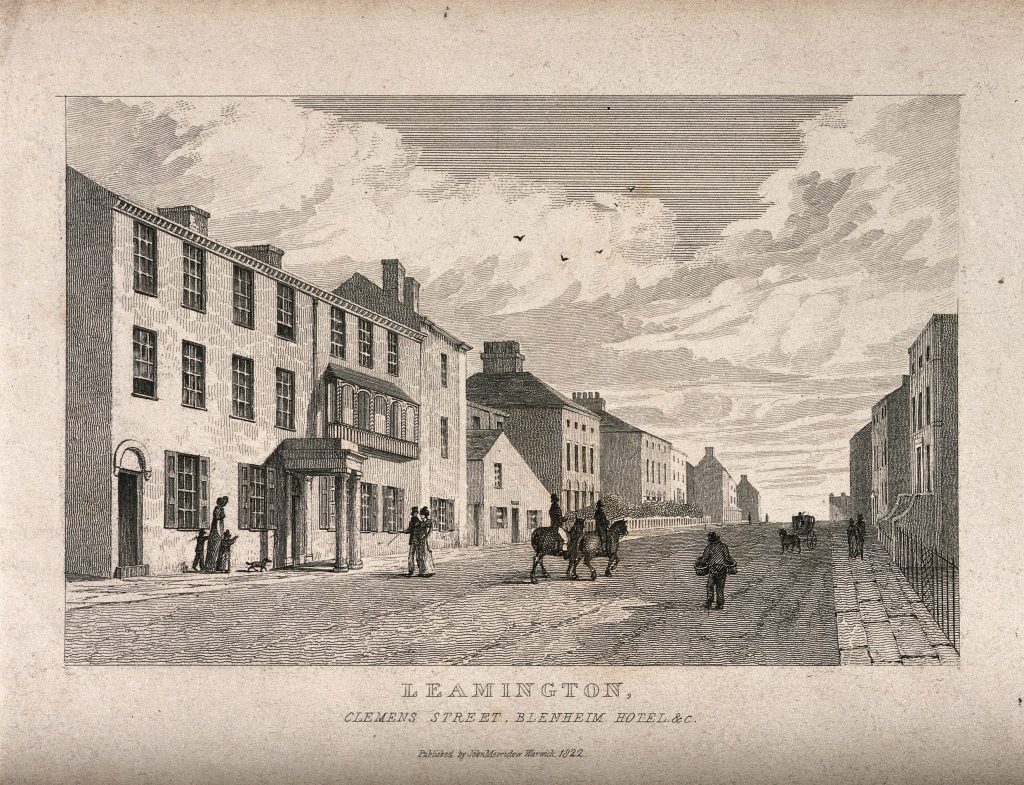
The Housewarming Dinner at the Bleinheim Hotel, on Thursday last, at which Col. O’HALLORAN presided, was very respectably attended. The repast consisted of every luxury in season, and was served up with great taste. The wines were excellent, and the dessert both choice and abundant. The evening was spent with the greatest harmony and conviviality; and the pleasures of the entertainment were considerably enhanced by the performances of Mr. Byrne, the Irish Harper, who executed some of his National Melodies with great animation and feeling.
Leamington Spa Courier, Sat 14 Jan 1832 p2
The town still overflows with company. All our principal Hotels abound with rank, youth, beauty, and fashion. From 50 to 60 persons sit down daily in the Table d’Hote, at the Royal Hotel, where, in addition to the harmonious strains of Mr. Byrn (the Irish Harpist), whose native melodies so much contribute to the pleasure of its numerous inmates, are not only to be found the most luxurious fare, but the most polished society.
Leamington Spa Courier, Sat 22 Sep 1832 p2
Presumably Byrne was away for the winter of 1832-3, but I don’t know where. By February ’33 he was back on duty.
Mr. P. Byrne, the Irish Harper, has resumed his usual station in the Entrance Hall of the Royal Hotel, and, to the great satisfaction of the inmates of that Establishment, daily performs, with all his wonted execution and pathos, some of the most popular melodies of his native land.
Leamington Spa Courier, Sat 16 Feb 1833 p2
It is possible that Byrne was in Leamington for the entire summer of 1833, from February through to November.
Mr. PATRICK BYRNE, the Irish Harper, who is well know to the numerous distinguished visitors who assemble at the Royal Hotel during the summer months, is about quitting Leamington for the land of his nativity; which will prove a source of great regret to the present inmates of that Establishment, to whom he is not less endeared by his unassuming manners, than by his assiduous endeavours to please by his skilled performances on his favourite instrument. He has paid his usual annual visit to his munificent patron, and on Thursday se’nnight, after playing “Auld lang syne” with more than his usual pathos, left the hospitable mansion of his benefactor at Eatington for Leamington. On Monday, he will take leave of his warm-hearted friends at the Royal, and, in a few short hours, the strains of the Blind Harper elicited as a parting tribute to friendship, will on Erin’s land, be succeeded by those of another of his favourite airs –
Leamington Spa Courier, Sat 30 Nov 1833 p2
The harp that once trough Tara’s hall,
The soul of music shed,
Now hangs as mute on Tara’s walls,
As if that soul was fled.
We can pick apart the events here. Byrne was at Ettington with Evelyn J. Shirley, for his “usual annual visit”; he stayed there until “Thursday se’nnight”, i.e. a fortnight before the article, and so I suppose on Thursday 14th November 1833 he left Ettington and went back to the Royal Hotel to do a couple more weeks of work there. He was due to leave Leamington to travel back to Ireland on Monday 2nd December 1833 – maybe travelling from Holyhead or Liverpool to Dublin. I think he would likely have been on the road for a couple of days or more.
My guess, is that perhaps Byrne spent the winter of 1833-4 in Ireland. I only have one note at the moment for these months:
A Correspondent in Castleblayney states that Mr. Byrne, the celebrated harper, has been performing in that town for several days, much to the satisfaction of the inhabitants.
Newry Telegraph, Fri 7 Mar 1834 p2
Byrne seems to have travelled back to Warwickshire in May 1834.
ROYAL HOTEL. – The table d’hote at this Establishment, so greatly distinguished for the fashionable and highly polished society which it invariably attracts, now begins to assume its accustomed brilliancy. Mr. BYRN, the Blind Irish Harper, having just returned from Ireland, has again resumed his usual station in the Entrance Hall of the Hotel, and, at intervals, throughout the day, executes some of the melodies peculiar to his country, in a style which contributes greatly to the pleasure of the numerous fashionable visitants now assembled at the establishment.
Leamington Spa Courier, Sat 7 Jun 1834 p2
So from June 1834 Byrne was installed every day in the Royal Hotel; presumably he stayed in England for the next few months, either working in the Hotel or travelling to the houses of his patrons. By the Autumn he had got further afield, almost as far as London. We are told about this incidentally after he had returned to Leamington in November:
That delightful Harpist, Mr. Patrick Byrne, has returned to his usual station, in the Hall of the Royal Hotel, where during the past week “the string of his harp with its musical swell” has imparted considerable pleasure to the many visitors at present residing at that splendid establishment. He has lately been on a professional visit to Lady Byron, and the poet’s interesting daughter, Ada, at her ladyship’s seat in the neighbourhood of London, both of whom expressed their unqualified approbation of his performance of some of those wild, yet pleasing melodies, peculiar to the Emerald Isle. He returns to his native country in a few days, after visiting of our country families.
Leamington Spa Courier, Sat 8 Nov 1834 p2
We can try to unthread this sequence of events. Presumably in October, Patrick Byrne was visiting Ann Byron, and her 19 year-old daughter Ada the famous mathematician and computer scientist; she had already met Babbage by this point and was working with the Difference Engine. Ada and her mother lived at Fordhook House, in Ealing, London.
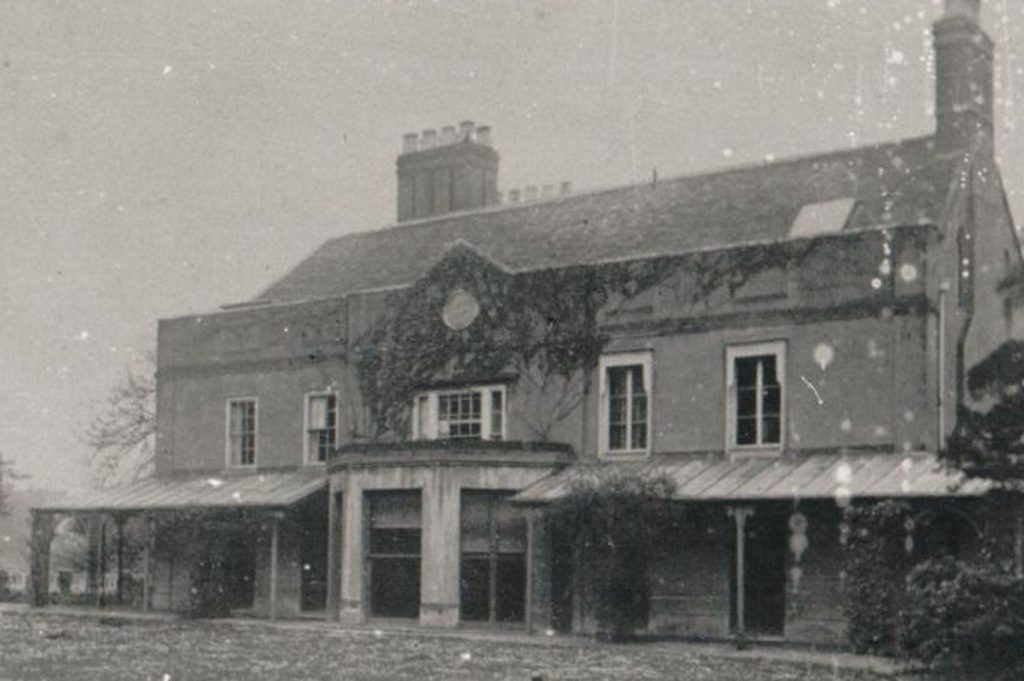
There must be interesting networks of connection between these patrons that we are not seeing. I note that Ada was already popular at the court and so I can imagine her telling other aristocrats about Byrne’s visit. But we only have these asides in the newspaper notices; so we don’t know who else Byrne was visiting at this time. It is too easy to imagine him going direct from Warwickshire to Ealing, and then straight back to the Royal Hotel. I am guessing that he was already well enough connected to go from house to house, staying for a few days or a week at each one, just like his first teacher Arthur O’Neil had described in his Memoirs for the mid to late 18th century.
It seems that Byrne travelled back to Leamington at the very end of October 1834, and spent the first week of November working at his regular job, playing in the Royal Hotel every day.
Then in the second week of November 1834 he seems to have gone to visit the big houses of his patrons around Warwickshire, perhaps including Evelyn J Shirley at Ettington, but also others who we don’t have information about.
On Monday 10th November 1834, one of these patrons wrote Byrne a letter of recommendation, which is preserved in Patrick Byrne’s private papers (PRONI D3531/G/1). The letter is addressed simply “Leamington” and I cannot really read the signature; It appears to say something like “G Fa??ham”. It begins “Dear Miss Saunderson, I am requested by Mr Byrne the blind Irish minstrel to give him an introduction…” It adds “He is Mr Shirley’s harper”, and it mentions that Byrne has been frequently at [Calton] and at Miss [Herbets] at [Calton]. I am really not sure what place this refers to, maybe Calton in Staffordshire, or Catton Hall in Derbyshire, or Colton in Staffordshire. All very unsatisfactory.
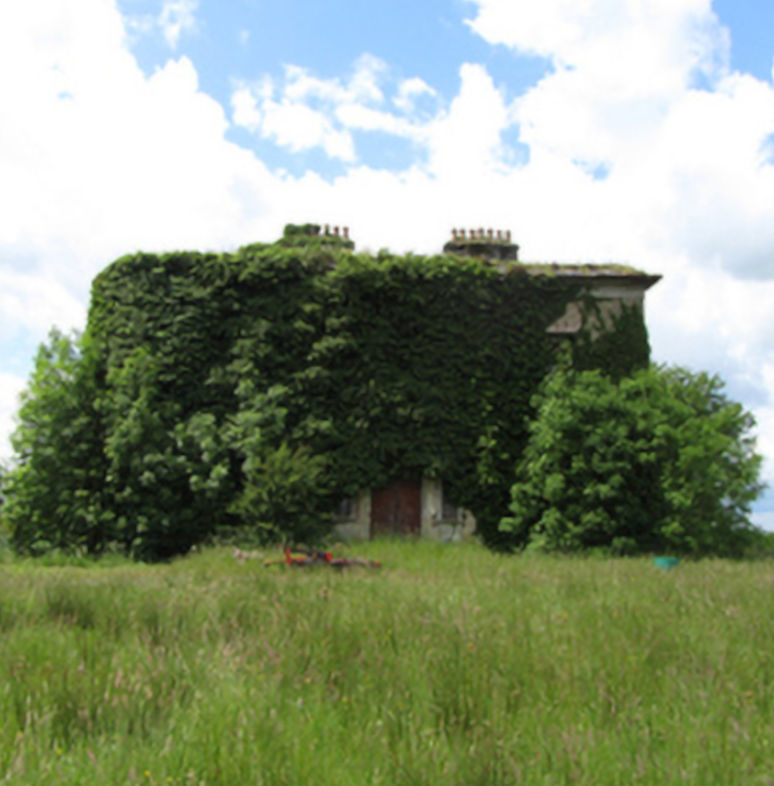
We can be on more solid ground with the recipient: Miss Saunderson, of Clover Hill, County Cavan. I think she must be Mary Anne Sanderson, who died in 1873. Presumably Byrne wanted to visit Cloverhill and so needed a letter of introduction from an established patron. We can imagine that maybe he carried the letter with him from Leamington to Cloverhill straight away, in mid to late November 1834, or perhaps later on that winter. We should note that after (presumably) showing it to Mary Anne Sanderson, Byrne kept hold of the letter. Unless of course he never actually got to Cloverhill…
I don’t have any information about what Byrne was doing in 1835. We have to imagine him keeping up his networks, visiting his regular patrons in Ireland and England – Shirley at Ettington and perhaps also Lough Fea; Price at Saintfield; Napier at Loughcrew, and I’m sure many others in Warwickshire and elsewhere, as well as presumably sometimes taking time to see his family in Magheracloone.
This is a long gap in our records, from the end of 1834 through to the summer of 1836, when we find him travelling from Ireland back to his regular job in Leamington.
The admirers of musical talent in Leamington will be pleased to hear that Mr. Patrick Byrne, the Blind Irish Harper, is returned to this town from a visit to his native country. He may again be heard playing some of the most delightful melodies of “old Ireland” in the hall of Copps’s Hotel; and his highly finished performances on the harp receive daily commendation from the numerous distinguished persons now sojourning at that splendid establishment.
Leamington Spa Courier Sat 11 Jun 1836 p2
Six months later we have him playing for the Stratford-upon-Avon Conservative Dinner (Leamington Spa Courier Sat 28 Jan 1837 p3, also Warwick and Warwickshire Advertiser Sat 28 Jan 1837 p3). E. J. Shirley was present and gave a very long speech which the newspaper printed in full. Byrne does not seem to have had a big role, and most of the music seems to be songs. Perhaps Shirley took him along.
Again I am sure he was doing loads of these, and the notices are the tip of the iceberg. Perhaps Byrne was living at Ettington and working for Shirley; but from Tuesday 16th May 1837 he was back on duty every day in the hotel.
The table d’hote for the season commenced at Copps’s Royal Hotel on Tuesday last, when a very select company of distinguished visitors partook of a repast of the most chaste and liberal description. The Blind Irish Harper (Mr. P. Byrne) was in attendance, and played several of his beautiful native melodies, in his usual excellent style.
Leamington Spa Courier Sat 20 May 1837 p2
By this point, Patrick Byrne was aged about 40.
Conclusion
It seems like this period of Byrne’s career has him settled in the usual pattern, of working at a hotel, and doing private events for wealthy patrons. But I think we can already see by comparing him with other traditional harpers, that he seems to be building his networks of patrons. It is very hard to know how much of this is because we have his private papers, and so can see “behind the scenes” in a way that we can’t for the others. But I also think that the way he was working in England at this time would have made a difference.
Byrne was discharged from harp school in 1822, and it looks like he may have spent the first four years or so of his career visiting Irish aristocrats in their big houses. Evelyn J. Shirley took him to England, apparently in about 1826, and once he was based there his regular job working in the Royal Hotel in Leamington Spa would have given him a lot of exposure to wealthy and influential people. And we shouldn’t underestimate his modest and unassuming manner; I think that wealthy English patrons would value that. And he was definitely able to leverage his novelty value; I am not sure any other harpers were touring in England at this time. Many of his audiences would never have seen or heard a traditional Irish harper playing the wire-strung Irish harp before.
There are gaps in this story of course; I am fully expecting to come across other references in due course that can fill in some of these gaps about when and where he was travelling and staying.
Towards the end of 1837 Byrne went to Edinburgh, and the descriptions of him start to become more florid and high powered. So we will save this next stage of his career and his growing public profile, for part 3.
Edit Tue 17th October 2023: part 3: 1837-1840 is now posted.
Map
I have added places around Warwickshire to my map. This view shows the same map as I showed in Part 1, but zoomed to the area around Leamington. Touch a dot to see its name, click it to get more info. You can also open the map in a new window.
You can also zoom right out to see Patrick Byrne’s places in Ireland. I will continue adding places to this map in future as I work on later periods of his life.
My header image is one of the photographs of Patrick Byrne, taken in Edinbugh in 1845. I created this image digitally from a scan of an original paper negative held by the Scottish National Portrait Gallery, accession number PGP HA 460, used under license CC-BY-SA.
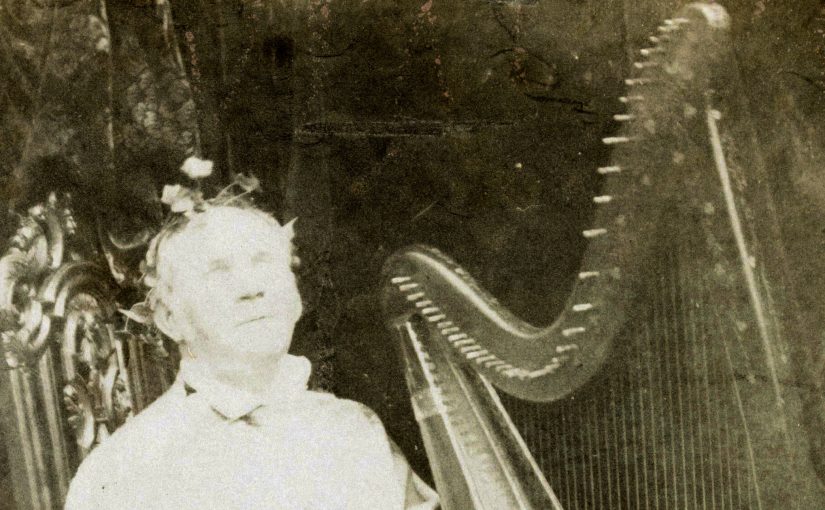
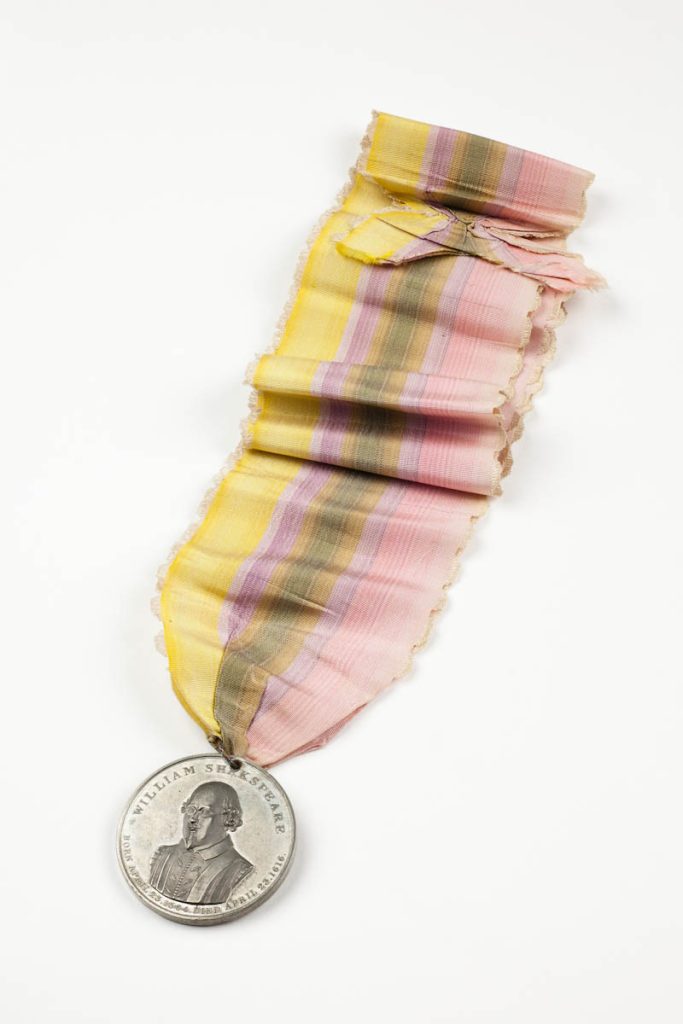
There is a biography of the poet James Martin (1783–1860) at DIB. His two different praise-poems for Patrick Byrne (both preserved in Byrne’s papers at PRONI) are actually quite interesting in what they talk about. Perhaps i will do a separate post about them at some point.
We have more information about Patrick Byrne going to Warwickshire in 1828:
John Scully in his book Ah How d’you do sir (Carrickmacross 2024) p.21 points out that the names of Byrne, and also of Mr and Mrs Napier, appears in the Leamington Spa Courier of Sat 16 Aug 1828, p.2, under “Arrivals”. I think it is reasonable so suppose, that this is Patrick Byrne the harper travelling from Ireland to Warwickshire with his patrons the Napiers of Loughcrew.
I found a newspaper advert and editorial for a benefit concert on Tue 17 March 1829, the month before Byrne was at the Shakespeare Club in Stratford-upon-Avon. The advert does not name the harper but I am thinking it must be Byrne, otherwise who else was in Warwickshire at that time?
I think that perhaps more than making money, this may have been intended to attract attention and patronage, and to be a way of getting other gigs.
I also found a notice from March 1837, that he was back at the Royal Hotel. This fits into the gap at the end of this post, just before the last article I put about the tabel d’hote restarting. This shows how one fragment can be found to fill in the story and the sequence of events.
The newspaper continues to report on “the snow which now covers the ground rendering out-door amusements impracticable”.